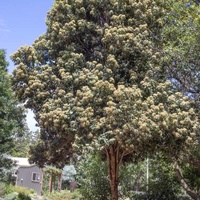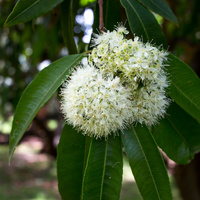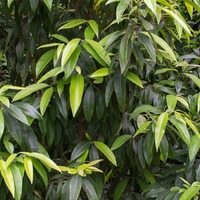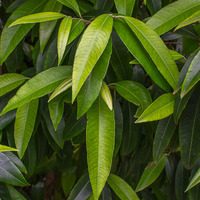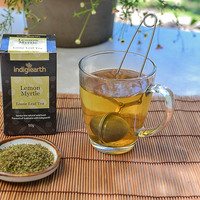Common name: Lemon Myrtle
Other common names: Australian Lemon Myrtle, Lemon Ironwood, Sweet Verbena Tree
Description
Lemon Myrtle is an ornamental and essential-oil yielding tree originating in Australia, its native range confined to pockets of subtropical forest on the continent's east coast.
It grows at a slow to moderate rate, in native forests to heights of up to 25 m (65 ft), with a straight, slim trunk up to 0.25 m (10 in) in diameter and clear of branches for more than half the tree height. On open sites, it is typically 5 to 10 m (15 to 30 ft) tall with a low-branching habit, forming a densely leafy pyramidal crown. The bark is thin, grey- or light-brown, rough and fissured, sometimes flaking.
Leaves are lance-shaped, 7 to 12 cm (2.8 to 4.7 in) long, lime green when young, changing to dark green, and with a strong lemon fragrance when crushed. They remain on the tree throughout the year.
Small creamy-white flowers with long stamens bloom in profuse clusters from spring to early summer, almost hiding the green foliage from view. Brown, woody seed capsules follow them with small seed inside. The seed are released when the capsules fall to the ground and split on impact.
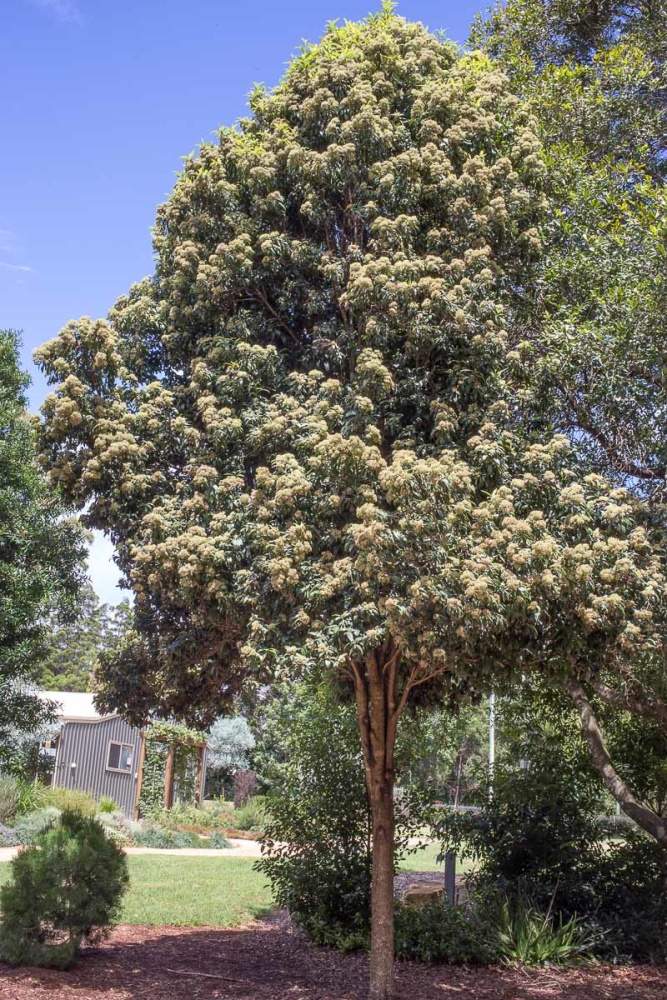
Peacehaven Botanic Gardens, Toowoomba, Australia
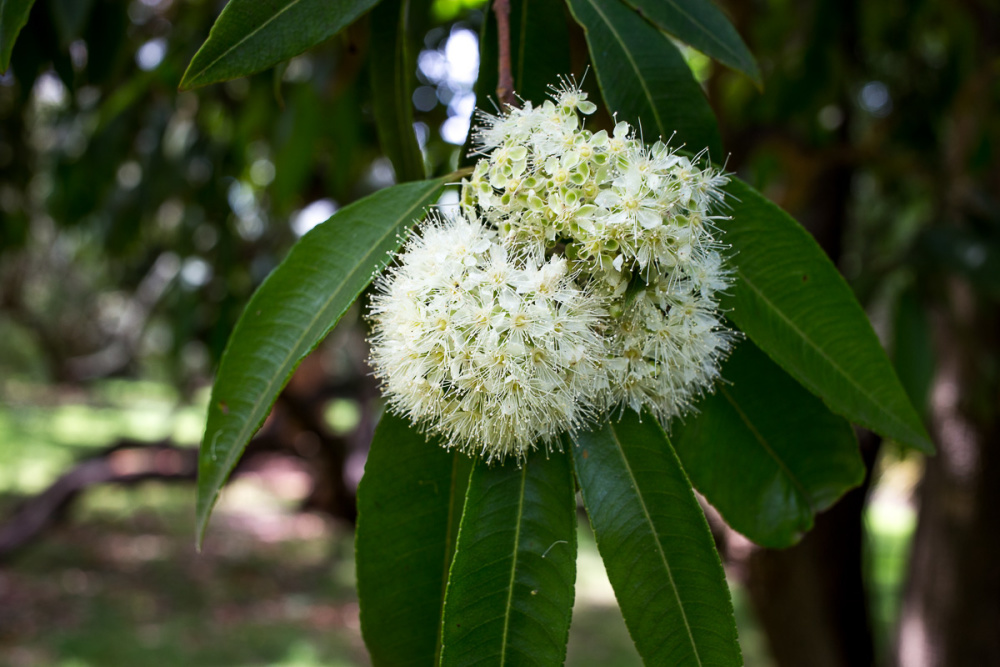
Flower cluster
Use
The leaves on steam distillation yield a pale yellow, lemon-lime scented essential oil used as a flavour and fragrance component and disinfecting agent in a wide range of products, including food, perfumes, medicines, cleaning and toiletry goods.
Lemon Myrtle oil has one of the highest citronella contents of any essential oil, probably second only to that of Lemon Eucalyptus (Corymbia citriodora), giving it insect repellent properties. Lemon Myrtle oil also possesses antimicrobial and antifungal activity, which has generated interest in its use as a natural food preservative. Corrosive to plastic, it must be stored and transported in glass or stainless steel containers.
Around 8,000 kgs of fresh leaves are harvested per hectare per year in commercial plantations. With an oil content from 0.7% to 1%, yields are 56 to 80 kgs of oil per hectare, equivalent to 50 to 70 pounds per acre.
The leaves are also used fresh or dried as a culinary herb to add flavour to sweet and savoury dishes, oils, syrups and preserves. They are also commonly brewed into a citrus flavoured tea.
The wood is heavy, averaging out at about 960 kgs per cubic meter (60 lbs per cubic ft) and has pale pink- to red-brown heartwood. Still, the logs come in diameters too small for sawing into lumber. The roundwood, when available, is used for turnery, tool handles and woodcraft more generally. Its natural durability to rot and decay and wood-boring insects is not well researched.
The plant's low-branching habit lends to it being grown as a fragrant hedge or privacy screen, with pruning needed to keep it to a desired height and shape.
Honeybees can be observed vigorously working the flowers, but their importance to honey production is unknown.
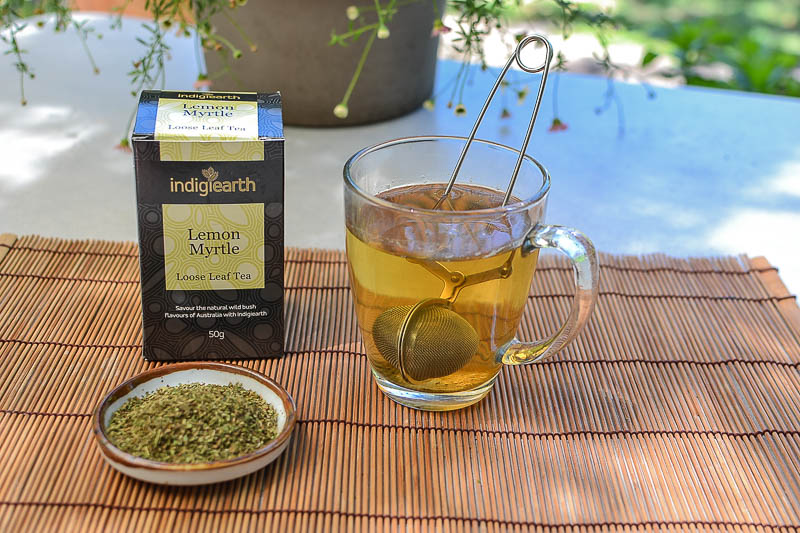
Climate
Lemon Myrtle grows naturally in moderately humid subtropical and tropical mid-elevation climates, generally best in frost-free areas with average annual lows of 9 to 19°C, average annual highs of 19 to 30°C, annual rainfall of 700 to 2000 mm and a dry season of 5 months or less.
Growing
New plants are usually started from semi-hardwood cuttings. It performs best on rich, moist, free-draining soil of a mildly acid to neutral nature, generally with a pH of 5.5 to 7.0 and on sites in partial sun exposure. It has poor tolerance to alkaline, slow-draining or waterlogged soils.
Problem features
There does not appear to be any record of it as a weed or as having naturalised anywhere in the world.
Where it grows
References
Books
-
Arctander, S. 1960, Perfume and flavor materials of natural origin, Elizabeth, New Jersey
-
Barwick, M., et al. 2004, Tropical & subtropical trees : a worldwide encyclopaedic guide, Thames and Hudson, London
-
Church, G. & Greenfield, P. 2002, Trees and shrubs for fragrance, David Bateman, Auckland, New Zealand
-
Groom, N. 1997, The new perfume handbook, 2nd ed., Blackie Academic & Professional, London
-
Lake, M. 2015, Australian rainforest woods : characteristics, uses and identification, CSIRO Publishing, Collingwood, Victoria
-
Leech, M. 2013, Bee Friendly: A planting guide for European honeybees and Australian native pollinators, Rural Industries Research and Development Corporation (RIRDC), Canberra, Australian Capital Territory
-
Macmillan, H. F. 1943, Tropical planting and gardening : with special reference to Ceylon, 5th ed, Macmillan Publishing, London
-
Oakman, H. 1995, Harry Oakman's what flowers when : the complete guide to flowering times in tropical and subtropical gardens, University of Queensland Press, St. Lucia, Queensland
-
Peate, N. & Macdonald, G. & Talbot, A. 2006, Grow what where : over 3,000 Australian native plants for every situation, special use and problem area, 3rd ed., Bloomings Books, Richmond, Victoria, Australia
-
Salvin, S. 2008, The new crop industries handbook : native foods, Rural Industries Research and Development Corporation (RIRDC), Barton, Australian Capital Territory
-
Seidemann, J. 2005, World spice plants: economic usage botany taxonomy, Springer-Verlag, Berlin
-
Woodward, Penny 1997, Pest-repellent plants, Hyland House, South Melbourne
